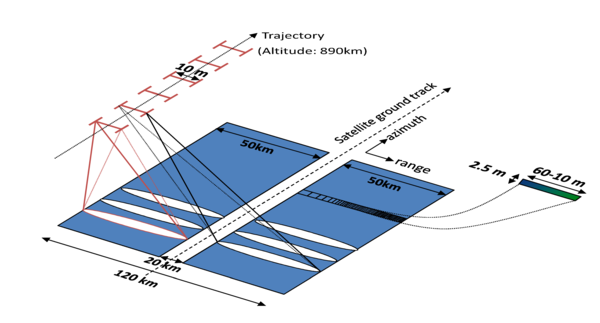KaRIn: Ka-band Radar Interferometer
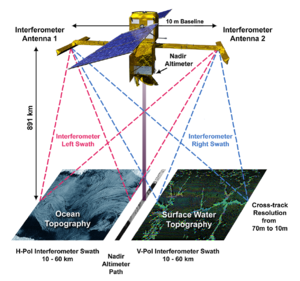
KaRIn (Ka-band radar Interferometer) is a new class of altimeter, taking into account all the experience of previous missions (altimetry, but also SAR sensors), proposing with brand-new capabilities of measuring surface heights.
The primary Swot instrument is an interferometric altimeter which has a rich heritage based on
(1) the many highly successful ocean observing radar altimeters,
(2) the Shuttle Radar Topography Mission,
and
(3) the development effort of the Wide Swath Ocean Altimeter (WSOA).
KaRIn is a near-nadir (1-4° look angles) swath-based instrument measuring the highly reflective water surface. The look angles at the altitude of the satellite entail swath coverage of about 120 km (from 10 to 70 km in cross-track distance on both sides of the nadir track). It is making measurements at Ka-band (35.75 GHz) with two Ka-band synthetic aperture radar (SAR) antennae at opposite ends of a 10-m boom.
Interferometry SAR processing of the returned pulses yields a 5 m azimuth and 10 m to 70 m range resolution, with instantaneous elevation precision of 50 cm. Spatial averaging over areas of 1 km2 improves this elevation precision to less than 2 cm.
KaRIn provides continuous mapping operating, starting at instrument switch-on.
See Techniques>Altimetry page dedicated to altimeter-interferometer for more information on how it is working.
To form the required baseline between the two antennae, KaRIn deployed two 5-m-long and 0.25-m-wide reflectarray antennas on opposite ends of a boom. Both antennas can technically transmit and receive radar pulses, but in the normal operation, only one is transmitting (emitting), and both are receiving. The interferometer is a dual-swath system, alternatively illuminating the left and right swaths on each side of the nadir track. This is accomplished by an offset dual-feed design operating with orthogonal linear polarizations (V and H polarizations), which enables the emitting reflectarray antenna to generate two separate beams, one for each polarization, and thus enabling to discriminate from which swath the reflection is coming when receiving it back.
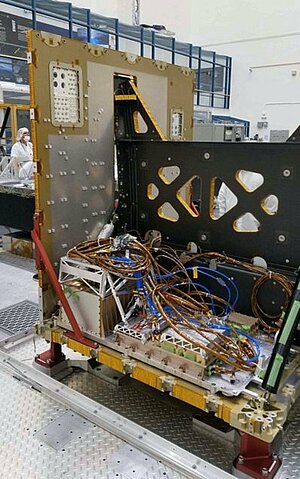
The KaRin instrument consists of:
The KaRIn Digital Electronics Subsystem (KDES):
The unit receives KaRIn commands from the spacecraft (S/C) and DORIS data (for altitude and navigation information) via the bus and sends KaRIn telemetry to the spacecraft via the same interface, acquires and packetizes telemetry from the rest of the instrument. It also receives and digitizes the echo information from the Radio Frequency Unit (see below). The KDES controls the radar hardware (Radio Frequency Unit, High Power Amplifier, alignment). To limit the data rate transmitted to the ground, the KDES converts the digitized data to interferograms. The data is transmitted to the solid state recorder at a maximum rate of about 360 Mbps.
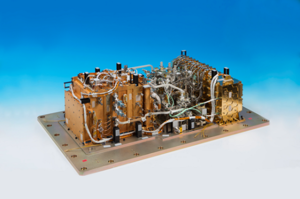
The Radio-Frequency Unit (RFU)
It is made of all the analog components needed to modulate/demodulate, amplify and convert in frequency the chirp reference signal up to the High-Power Amplifier. The two main subsystems which form the RFU are the Duplexer, which is the switching matrix of the Radio Frequency signals and the HyperBox, which implements all other functions of the RFU : Pulses generation/emission & Echoes reception / Ka band up & down conversion.
The HPA (High Power Amplifier)
The HPA amplifies the chirped Radio Frequency signal sent by the RFU to 1500 W for transmission to the ground. The HPA consists of an Extended Interaction Klystron (which amplifies the low power radar signal), a JPL-built High Voltage Power Supply and a NASA-provided High Power Isolator/Filter. The HPA is block-redundant due to the criticality of this equipment.
Deployable Antenna Assembly
It is a high precision, high stiffness, and stable deployable structure which allows the radar reflector arrays to be perfectly positioned in relation to the sources mounted on the supporting structure. The assembly consists of an integrated Mast Assembly (IMA) and an Integrated Reflector Array (IRA). It shall be as rigid as possible to guarantee a stabilized baseline. It is mostly built of carbon composite parts. The Integrated Reflector Array includes an alignment mechanism which can correct the pitch misalignment between the two reflectarrays.
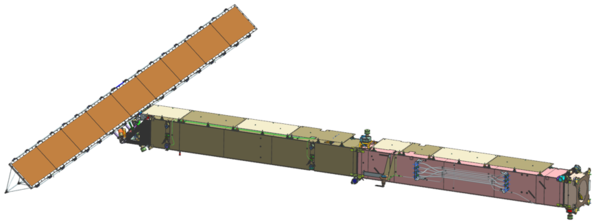
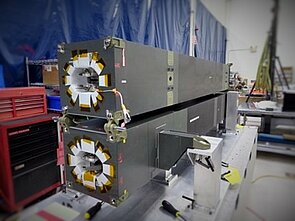
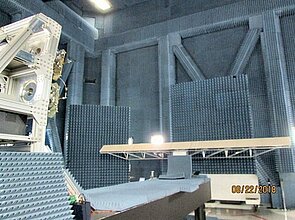
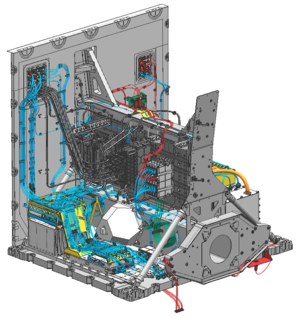
The KaRIn Inertial Reference Unit (Gyro)
KaRIn includes a high-performance Inertial Reference Unit (IRU) to measure the orientation of the mechanical baseline. Having a stable orientation was already important with nadir altimeters; it is even more important with Swot since stability is required in the 3 dimensions.
The unit is part of a flight-proven product line. It is a fiber optic gyro, sensing the angular rate using an optical signal traveling through a 5 km coil of optical fiber. There is no moving part. Optical fiber is available with very long life. The IRU has a built-in fault tolerance – four entirely independent channels, any three of which are sufficient.
KaRIn System parameters
| Parameter | Value | |
|---|---|---|
| Center frequency | 35.75 GHz | 8.4 mm wavelength |
| TX Bandwidth | 200 MHz | 0.56 % bandwidth |
| TX Pulse length | 5.7 us | Capability to operate within 3 - 9 us |
| Pulse Repetition Frequency (average) | 2 x 4420Hz | Varies by < 5% along the orbit |
| Peak Transmit Power (EOL) | 1500W | |
| Physical Baseline Length | 10 m | |
| Antenna size | 5 mx 0.25 m | |
| Boresight Look Angle | +/- 2.65 deg | Swath look angles -0.65° to 3.9° |
| Polarization, Right Swath | VV | Alternating polarizations between |
| Polarization, Left Swath | HH | consecutive pulses to 'illuminate both swaths. |
